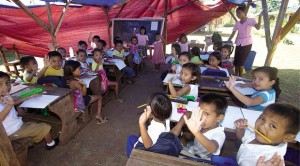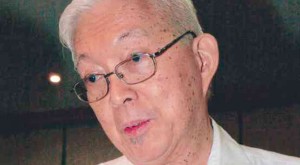
CLASSROOM WITHOUT WALLS Learning is more fun in Bantayan, these young students seem to say, as they hold classes in makeshift classrooms more than a month after Supertyphoon “Yolanda” flattened schools in northern Cebu province. EDWIN VICENCIO/CONTRIBUTOR
MANILA, Philippines—Three months after Super Typhoon Yolanda devastated the central Philippines, some 420,000 children from the worst-hit areas are back in school with the help of the United Nations Children’s Fund (Unicef) and its partners.
The children are in repaired, makeshift and tent schools using learning materials from school-in-a-box, early childhood and recreational kits. Unicef said in a statement that much remained to be done to address the significant challenges, including the continued large-scale displacement of families and communities, damaged infrastructure and lost livelihoods, and increased threat from diseases like dengue and measles.
As many as 14.1 million people, including 5.9 million children, were affected when Yolanda struck on Nov. 8. After a vulnerability assessment, Unicef, in partnership with local government units (LGUs), decided to focus its attention on the 40 most severely affected municipalities, which are home to around 1.34 people, including 558,000 children.
“Our focus to date has been on providing life-saving aid to those children and communities that were hardest hit…and who are most at risk,” said Angela Kearney, the Unicef representative in the Philippines.
“We are making real progress, but so much more needs to be done to restore these children’s rights and to return to them their chance to fulfill their potential. Unicef staff are working around the clock to provide urgently needed assistance.
“Under the leadership of the Philippine government and with humanitarian partners and LGUs, Unicef has been fast-tracking the delivery of aid and suppport—restoring access to clean water and sanitation, ensuring immunization against dangerous diseases and fostering child health (with the World Health Organization), addressing maternal and neonatal undernutrition, reestablishing education and early childhood development capacities, and ensuring that children are protected from abuse and exploitation.
“Every day, we are expanding our support, looking to ensure that every child’s needs and rights are met,” said Kearney.


